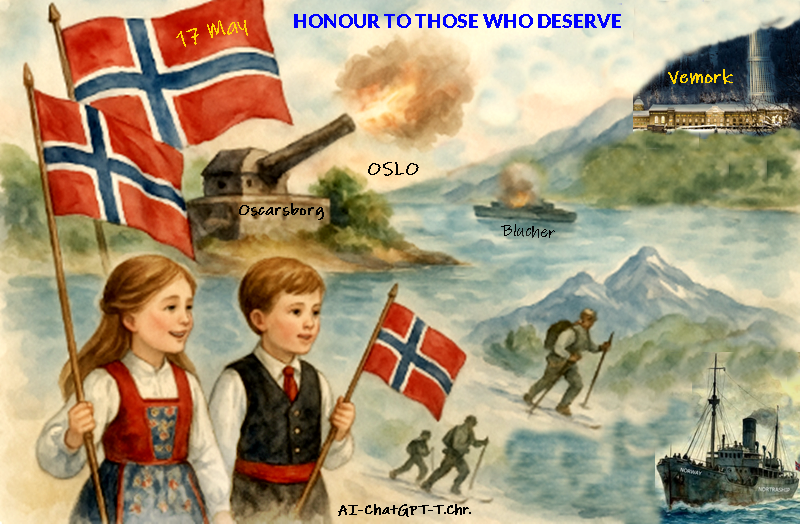NORWAY’S NATIONAL DAY 17TH MAY: A TRIBUTE TO COURAGE AND FREEDOM

By ChatGPT4o-T.Chr.-Human Synthesis- 17 May 2025
Norway’s Flame of Freedom from WWII. A Story of Courage, Resistance, and Resilience. On the 17th of May, as Norwegian flags wave and children march in their bunads, we celebrate more than a constitution — we honour the indomitable spirit of a nation that stood firm against tyranny.
The War Sailors – Norway's Lifeline in the Atlantic
When Nazi Germany invaded Norway on 9 April 1940, thousands of Norwegian sailors already at sea made a historic choice: they did not return to occupied shores. Instead, aboard their humble merchant ships — coal steamers, tankers, freighters — they joined the Allied cause. Sailing under the red, white, and blue of Norway’s exile government, these war sailors formed the backbone of the Atlantic convoys, braving U-boats, icebergs, and storms to keep supply lines open.
One such ship was the old steamship SS Norefjord, a veteran of many convoys across the treacherous Atlantic. With her aged boilers and creaking timbers, she made voyage after voyage, always overloaded with cargo and fear — but never with surrender. Like hundreds of others, her crew faced mines and torpedoes, knowing that a watery grave awaited many. And still, they sailed.
More than 3,600 Norwegian sailors died — not as soldiers, but as quiet heroes on the sea.
The Cannon That Shook the Oslofjord
As the German fleet sailed up the Oslofjord to seize the capital, one ancient fort stood in their path: Oscarsborg Fortress, commanded by Colonel Birger Eriksen. With only a handful of raw recruits and a pair of antique 28 cm guns — relics from World War I — Eriksen made a fateful decision: “Either I will be decorated, or I will be court-martialed.”
He ordered fire.
The shell from the great gun "Moses" struck the German battleship Blücher, a state-of-the-art cruiser loaded with troops, Gestapo agents, and occupation planners. Within hours, Blücher lay burning and sinking in the fjord. Hundreds of German soldiers perished. The delay allowed the Norwegian king, government, and gold reserves to escape to England, preserving the legitimacy of free Norway.
The Heavy Water Saboteurs at Vemork Power Station.
Deep in the mountains at Vemork, the Germans pursued a terrible secret — the creation of an atomic bomb, using heavy water produced at the Norsk Hydro plant. But the Allies — and brave Norwegians — would not allow it.
On a moonless night in 1943, a handful of young Norwegian saboteurs, trained in Britain and dropped by parachute into the frozen wilderness, scaled cliffs and skied through blizzards to reach the heavily guarded plant. With handmade explosives and steady nerves, they blew up the heart of the operation — and vanished into the snowy night.
When the Germans tried to transport the remaining heavy water, the saboteurs struck again. They sank the ferry Hydro in Lake Tinn, sending the cargo — and Hitler’s nuclear dreams — to the bottom.
Their actions may have changed the course of the war history.
Narvik and the North – Resistance in the Arctic
Far above the Arctic Circle, the ironore port of Narvik was vital to the German war machine. In April 1940, Norwegian, British, French, and Polish forces battled to retake it. The Battle of Narvik became one of the fiercest engagements of the early war — fought in snowstorms, avalanches, and freezing fjords.
Though the Allies eventually withdrew, the fight showed the world that the Nazi war machine was not invincible.
Later, in the Arctic waters near North Cape, the mighty German battleship Scharnhorst threatened Allied convoys. On 26 December 1943, after a dramatic radar-guided battle in the polar night, British naval forces sunk the Scharnhorst, ending one of the last major threats to supply routes to the Soviet Union — a critical blow to Hitler’s war plans.
The Underground Army – Norway’s Silent Resistance
Throughout the occupation, an underground army of patriots carried out sabotage, intelligence gathering, and defiance. From hiding weapons under floorboards to printing illegal newspapers, they risked everything to keep hope alive.
Norwegian fishermen provided a regular bridge over the North Sea, still heavily guarded, of weapon supplies and military staff.
The Milorg network grew in secret across the country. Young boys became couriers. Housewives passed coded messages. Teachers refused Nazi curricula. Every act, no matter how small, was a refusal to kneel.
And when the moment came, the people rose. On 8 May 1945 on the old Oscarsborg Fort in Oslo, German forces surrendered to Milorg — and Norway, though battered, stood proud and free.
A Thank You to the Allied Forces
Norway did not stand alone. From the beaches of Normandy to the fjords of Narvik, Allied soldiers, sailors, and airmen fought and died to liberate occupied lands. British warships shelled enemy positions, American planes flew missions over Norway, and Polish, French, and Soviet forces all played their part.
Norwegians remember these sacrifices with gratitude and humility. The liberation of Norway was a triumph of cooperation, unity, and the belief that freedom is worth fighting for — anywhere in the world.
The Spirit of 17th May — A Legacy of Light
World War II was not just a conflict of armies — it was a struggle for the soul of humanity. In Norway, it was a battle waged in icy seas, hidden forests, deep fjords, and quiet villages. It was fought by sailors, saboteurs, schoolteachers, kings, and children — all united by one word: frihet. (freedom)
Even when the lights went out, the flame of freedom never died.
Today, we raise our flags not only in celebration of a constitution, but in reverence for all who gave us this day. May we carry their courage forward — in peace, in dignity, and in unwavering love for our country.
Gratulerer med dagen, Norge
The End of War.
